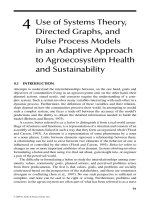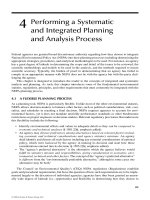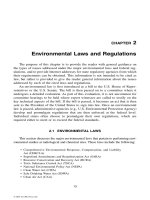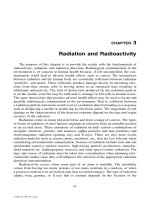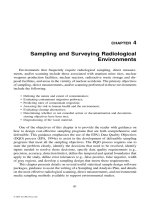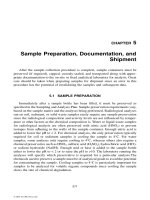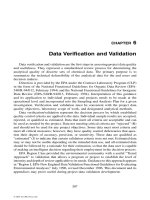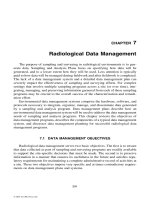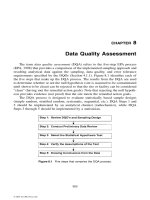Air Sampling and Industrial Hygiene Engineering - Chapter 4 pps
Bạn đang xem bản rút gọn của tài liệu. Xem và tải ngay bản đầy đủ của tài liệu tại đây (94.69 KB, 17 trang )
CHAPTER 4
Statistical Analysis and Relevance
This chapter contains theoretical and real-world discussions about statistical analysis. It gives
special emphasis to situations where knowledge of statistical relevance is a prerequisite for sampling
adequacy. It also illustrates the difference between log-normal and normal distribution and para-
metric monitoring data.
4.1 DEFINITIONS
In statistical analysis and relevance, certain standard definitions are used. The follow-
ing standard definitions and examples illustrate the basic concepts.
• Accuracy: Agreement of the measured value (i.e., empirical value) and the “true
value’’ (i.e., accepted reference value) of the sample given valid sampling tech-
niques, proper sample preparation, and reliable and accurate instrumentation
and/or other procedures.
Accuracy is often estimated by adding (or “spiking’’) known amounts of the
target parameters. For asbestos quality assurance (QA) sampling, accuracy is
evaluated by comparing analyses of duplicate samples that have been evaluated
in proficiency in analytical testing (PAT) round robins (for air samples) or NIST
National Voluntary Laboratory Accreditation Program (NVLAP) proficiency test-
ing (for bulk and transmission electron microscopy [TEM]).
Accuracy is a measure of the bias of the method and may be expressed as the
difference between two values, a ratio, or the percentage difference.
• Analysis: Combination of sample preparation and evaluation.
• Audit: Systematic determination of the function or activity quality.
• Bias: Systemic error either inherent in the method or caused by measurement sys-
tem artifacts or idiosyncrasies.
• Blind sample: Presented to the laboratory as indistinguishable from field sam-
ples (syn: performance audit samples). All field blanks are to be presented to the
laboratory as blind samples for asbestos air samples.
• Calibration: Comparative procedure in which singular measurements are evalu-
ated against an accepted group of measurements. The evaluation may be against
a primary, intermediate, or secondary standard.
© 2001 CRC Press LLC
• Calibration curve: Range over which measurement can take place (syn: standard
curve, multipoint calibration).
• Calibration standard: Instruments or other measurement techniques used to
evaluate the measurement system. Ideally, these standards do not directly incor-
porate or use the target parameters to be measured.
• Chain-of-custody: Defined sample custody procedures that must be followed to
document the transition from field collection to subsequent transfer sites (com-
mon carriers, laboratories, storage facilities, etc.).
• Check standard: Used to verify that the initial standard or calibration curve
remains in effect. It ideally incorporates standard materials (syn: daily standard,
calibration check or standard, reference standard, control standard, single point
response factor, single point drift check).
• Comparability: Confidence with which one set of empirical data can be com-
pared to another.
• Completeness: Amount of valid data obtained from a measurement system
compared to the amount expected.
• Data quality: Totality of data parameters that identify ability to satisfy or repre-
sent a given condition; includes accuracy, precision, representativeness, and com-
parability.
• Data reduction: Using standard curves to interpret raw data.
• Data validation: Review process that compares a body of data against a set of cri-
teria to provide data adequacy assurance given the data’s intended use; includes
data editing, screening, checking, auditing, verification, certification, and review.
• Detection limit: Minimum target parameter quantity that can be identified, i.e.,
distinguished from background or “zero’’ signal.
• Double-blind sample: When neither the composition nor identification of the
sample is known to the analyst.
• Duplicate sample (field or laboratory): Sample divided into two portions, with
both portions carried through the sample preparation process at the same time.
For asbestos air samples, field duplicates are air samples collected at the same
time as the compliance air samples, and lab duplicates are portions of one filter
that are fixed and analyzed separately.
• Environmentally related measurements: Field or laboratory investigations that
generate data involving chemical, physical, or biological parameters characteris-
tic of the environment.
• Field blanks: Generated at the time of sampling, field blanks provide a check on
contamination, starting with the sampling process and proceeding through the full
analysis scheme. For asbestos fiber concentration sampling, field blanks are filter
cassettes transported to the site and exposed to ambient conditions. The filter caps
are removed from the filter cassettes; however, a vacuum air pump is not used to
pull air across the filter cassettes. Thus, the cassettes are exposed to the environ-
mental airstream of the surrounding environment outside the asbestos control area.
• Good laboratory practices: Performing a basic laboratory operation or activity so
as not to influence data generation quality.
• Instrument blank: Used to obtain information on instrument aberration
absence/presence. The measurement instrument is presented with materials
normally within the instrument and cycled through the measurement sequence.
The resulting signal is then defined as the baseline instrument signal level.
• Internal standard: A nontarget parameter added to samples just prior to measure-
ment to monitor variation in sample introduction and stability and to normalize
© 2001 CRC Press LLC
data for quantitation purposes. Internal standards are not usually used in bulk
(phase light microscopy [PLM]) or phase contrast microscopy (PCM); however,
these standards may be applicable to TEM protocol.
• Laboratory blank: Prepared in the laboratory after receipt of samples from the
field. These blanks are prepared using a material assumed not to contain the tar-
get parameter. Lab blanks for asbestos sampling are filter membranes obtained
from filter cassettes that have been retained in the laboratory without removal of
the filter cassette caps. The lab blank is a check on all the chemicals and reagents
used in the method as well as the influence of the general laboratory environment
(syn: analytical blank, system blank, method blank, process blank).
• Measurement: Creating quantitative data from a prepared sample.
• Method check sample: Prepared in the laboratory by spiking a clean reference
matrix with known quantities of the target parameters. For asbestos air-sampling
analysis, method check samples are previously prepared filters evaluated by sep-
arate analysts within the same laboratory. These duplicate analyses are defined in
the National Institute of Occupational Safety & Health (NIOSH) 7400 method as
quality assurance, and the acceptable statistical parameters are outlined therein.
• Method detection limit: Minimum quantity that a method (i.e., both sample
preparation and target parameter measurement steps) can be expected to distin-
guish from background or “zero’’ signal. This limit takes into account losses dur-
ing preparation and measurement and instrument sensitivity that may contribute
to qualification or quantification of results. This limit does not apply to physical
parameters (i.e., density, temperature).
• Performance evaluation (PE) sample: Sample with known “true’’ values that is
presented to the laboratory as a “performance evaluation sample.’’ These sam-
ples are biased by the analyst’s knowledge of the intent of the sample. For
asbestos air-sampling analysis, “true’’ value samples may be defined as the PAT
samples with their inclusive statistical ranges.
• Precision: Measure of the reproducibility of a set of results obtained under simi-
lar conditions. Precision is determined by multiplicate analysis of samples, dupli-
cates, replicates, or splits. Standard deviation is used as a measure of precision.
• Procedure: Systematic instructions and operations for using a method of sam-
pling or measurement.
• Proficiency sample: Samples for which known composition values are available
for accuracy comparisons. The composition values may be qualitative, quantita-
tive, or statistical ranges of acceptable qualitative/quantitative results.
• Quality assurance: An orderly assemblage of management policies, objectives,
principles, and general procedures by which a laboratory outlines the methods
used to produce quality data. QA is an intralaboratory function. Note: The
NIOSH 7400 method defines QA in terms of both intralaboratory and interlabo-
ratory methods and/or sequencing. However, for the purposes of specified
QA/quality control (QC) documents, interlaboratory methods are defined as QC.
• Quality control: Routine application of procedures used to develop prescribed
performance standards in the monitoring and measurement of standards. QC is
an interlaboratory function.
• QC samples: Analyzed concurrently with field samples to insure that analytical
systems are operating properly, i.e., in control. These samples provide an estimate
of the precision and accuracy of the sampling and analysis system. QC samples
for asbestos sampling are sent between laboratories for interlaboratory compar-
isons of methodology and analytical proficiency.
© 2001 CRC Press LLC
• Quality of method: Degree to which the method functions free of systemic error,
bias, and random error.
• Quantitation limits: Maximum and minimum levels or quantities of a reliably
quantified target parameter. These limits are bounded by the standard curve lim-
its and are generally related to standard curve data.
• Reagent blank: Used to identify contamination sources. These blanks incorpo-
rate specific reagents during sample preparation to identify lab blank contami-
nate sources (syn: dilution blank).
• Recovery/percent recovery: Generally used to report accuracy based on the
measurement of target parameters, comparison of these concentrations, and cor-
relating these measurements to the predicted amounts. Recovery in asbestos air
sampling is the statistical percentage differential observed during accuracy eval-
uation (i.e., percentage difference in fiber concentrations).
• Replicate samples (field or laboratory): A sample is divided into two portions
and is processed as two completely separate and nonparallel samples, i.e., pre-
pared and analyzed at different times or by different people. Field replicates in
asbestos air sampling are defined as filters that are obtained from two separate
filter cassettes drawn separately or from a y-juncture. These are then transported,
fixed, and analyzed separately. Lab replicates are taken from a singular filter,
which is sectioned, fixed, and analyzed separately.
• Representativeness: Degree to which data accurately and precisely represent a
parameter variation characteristic at a sampling point and portray an environ-
mental condition.
• Sample custody: Verification and documentation procedure for the transfer of
samples from the field to the laboratory, within the laboratory, and to the final
storage or disposal destination.
• Sample Operation Procedure (SOP): Procedure adopted for repetitive use when
performing a specific measurement or sampling operation.
• Sample preparation: Transformation of the sample into appropriate forms for
transfer and/or measurement.
• Sampling: Removal of a process stream representative portion or a portion of a
larger quantity of material for subsequent evaluation.
• Sensitivity: An instrument’s detection limit given the minimum quantity of a tar-
get parameter that can be consistently identified, i.e., distinguished from back-
ground or “zero’’ signal by the instrument; ideally established using the materials
that are used for standardization.
• Split samples (field or laboratory): A sample, divided into aliquots, that is sent
to a different laboratory for preparation and measurement. These split samples
may be replicates or duplicates that are then defined as splits when sent to
another laboratory for QC analysis. For asbestos air samples this shipment
involves either the shipping of capped filter cassettes (field split) or the shipping
of fixed slides (lab split).
• Standard materials: Materials, such as mixtures of the target parameters at
known concentration and purity, used to carry out standardizations. For asbestos
air sampling these materials may be PAT samples.
• Standardization: Establishing a quantitative relationship between known target
parameters input and instrument readout.
• Target parameters: Entity for which qualitative or quantitative information is
desired.
© 2001 CRC Press LLC
• Trip blanks: Essentially field blanks that do not have the caps removed. These
blanks provide insight into the contamination generated as a result of the shipping
process. These blanks are generally not required for asbestos sample shipment.
4.2 EXAMPLE—OUTLINE OF BULK SAMPLING QA/QC PROCEDURE
Bulk sample analysis procedures are defined in the NIOSH method for PLM and the
NIOSH 7402 method for TEM. Because bulk sample analysis is done by an independent
laboratory off-site, this QA/QC document will not address bulk sampling as a field-
verified procedure. The NVLAP is currently used to ascertain laboratory effectiveness. The
contractor must provide proof that NVLAP certification is current for the laboratory des-
ignated to receive both the initial bulk samples and the 10% bulk sample duplicates.
The optical properties and ID of fibers are as follows:
• Determine 13 specific items for asbestos.
• ID other fibers with some optical data.
• ID matrix components.
In addition record
• Special procedures or solvents
• Sampling of layers
• Deviations from EPA test procedure
The 10% bulk sample duplicates are provided by physically dividing 10% of the sam-
ples collected. This division should occur concurrently with the collection of field samples.
The rationale for splitting the samples at a time and location removed from the field col-
lection site must be provided.
All field collection procedures, sample labeling, and transport and disposal procedures
must be addressed in the QA/QC document. Provide the rationale for the classification
and remediation of errors. The following is a sample of error classification:
Major Error
• False positive
• False negative (asbestos actually Ͼ1%)
• Incorrect asbestos type classification
• Analysis quantification in error by 25%
Minor Error
• Incorrect ID of tremolite or actinolite as another type of asbestos
• False negative (asbestos actually Ͼ1% or trace)
• Analysis quantification in error by 15%
• Incomplete lab data sheets (repeated omissions may equal major error)
Corrective Steps—Major Errors
• Take immediate action.
© 2001 CRC Press LLC
• Review documents for transcription errors.
• Review sample, especially matrix description.
• Reanalyze sample; submit to other labs for analysis.
• Check environment for contamination and out of calibration equipment.
• For misidentification of asbestos species review literature and reference samples.
Corrective Steps—Minor Errors
• One to two weeks or after monthly summaries
• Steps 1 through 4 above.
• Review to determine if error is systematic estimation bias, then retrain on esti-
mation techniques and/or sample preparation techniques.
• Completed data sheets are required; frequent omissions should be considered a
major error.
• Review sampling and stereomicroscope sample preparation procedures.
• To recalibrate estimation techniques, reanalyze known samples; review literature
on estimation training.
• Review; retrain on reference samples, especially in problem matrix mixtures.
Review specific problems like tremolite or crocidolite samples.
• Review lab’s special sample preparations for Vinyl Asbestos Tile (VAT) or tar
matrix materials. Practice on known materials including blanks.
4.3 EXAMPLE—OUTLINE OF THE NIOSH 7400 QA PROCEDURE
4.3.1 Precision: Laboratory Uses a Precision of 0.45
Current guide specifications give a precision of 0.45 as acceptable in calculation of the
95% upper confidence level (UCL). Using a precision of 0.45 implies that the standard devi-
ation divided by the arithmetic mean gives a value of 0.45. This ratio is variously called the
coefficient of variation (CV) or the SR in the NIOSH 7400 method. With the 90% confidence
interval of mean count, which includes a subjective component of 0.45 plus the Poisson
component, 0.45 precision implies that reproducibility of results is questionable. Thus, the
use of the 0.45 value in the calculation of the UCL must be clearly identified. For compli-
ance purposes the following equation is acceptable:
Measured ϩ (air quality) (0.45) (1.645) concentration (standard)
The QA procedures given in the NIOSH 7400 method must be referenced in a discus-
sion of the 0.45 precision value used. Detailed outlines of the intralaboratory procedures
are not necessary. Proof of acceptable PAT participation (i.e., judged proficient for the tar-
get parameter in four successive round robins) as administered by the American Board of
Industrial Hygiene (ABIH) must be provided.
4.3.2 Precision: Laboratory Uses a Precision SR that is Better Than 0.45
When a precision better than 0.45 is suggested, an outline of the NIOSH 7400 QA pro-
cedures used and a current CV curve must be provided in addition to the proof of accept-
able PAT participation. The outline must include the following:
© 2001 CRC Press LLC
• Document the laboratory’s precision for each counter for replicate fiber counts by
using this procedure.
• Maintain as part of the QA program a set of reference slides to be used daily.
These slides should consist of filter preparations including a range of loading and
background dust levels from a variety of sources including both field and PAT
samples.
—Have the QA officer maintain custody of the reference slides and supply each
counter with a minimum of one reference slide per workday. Change the labels
on the reference slides periodically so that the counter does not become famil-
iar with the samples.
—From blind repeat counts on the reference slides, estimate the laboratory intra-
and intercounter SR.
—Determine separate values of relative standard deviation for each sample
matrix analyzed in each of the following ranges. Maintain control charts for
each of these data files.
• 15 to 20 fibers in 100 graticule fields
• Ͼ20 to 50 fibers in 100 graticule fields
• Ͼ50 to 100 fibers in 100 graticule fields
• 100 fibers in less than 100 graticule fields
Note: Certain sample matrices (e.g., asbestos cement) have been shown to give poor
precision. Prepare and count field blanks along with the field samples. Report counts on
each field blank.
Note 1: The identity of blank filters should be unknown to the counter until all counts
have been completed.
Note 2: If a field blank yields greater than 7 fibers per graticule fields, report possible
contamination of the samples.
• Perform blind recounts by the same counter on 10% of filters counted (slides rela-
beled by a person other than the counter). Use the following test to determine
whether a pair of counts by the same counter on the same filter should be rejected
because of possible bias:
• Discard the sample if the absolute value of the difference between the square
roots of the two counts (in fiber/mm
2
) exceeds 2.8 (x) 2 Ϫ 8 ϫ SR, where x ϭ the
average of the square roots of the two fiber counts (in fiber/mm
2
) and SR ϭ one
half the intracounter relative standard deviation for the appropriate count range
(in fibers).
Note 1: Fiber counting is the measurement of randomly placed fibers that may be
described by a Poisson distribution; therefore, a square root transformation of the fiber
count data will result in approximately normally distributed data.
Note 2: If a pair of counts is rejected by this test, recount the remaining samples in the
set and test the new counts against the first counts. Discard all rejected paired counts. It is
not necessary to use this statistic on blank counts.
The analyst is a critical part of this analytical procedure. Care must be taken to provide
a nonstressful and comfortable environment for fiber counting. An ergonomically
designed chair should be used. With the microscope eyepiece situated at a comfortable
height for viewing. External lighting should be set at an intensity level similar to the illu-
mination level in the microscope to reduce eye fatigue. Counters should take 10–20 min
© 2001 CRC Press LLC
breaks from the microscope every 1 to 2 hours to limit fatigue. During these breaks both
eye and upper back/neck exercises should be performed to relieve strain.
Calculation of compliance uses the same equation with the substitution of a different
value for 0.45. Use of this different value requires prior approval. All filters selected for the
10% recount should be randomly selected, rather than selecting every tenth filter.
4.3.3 Records to Be Kept in a QA/QC System
Records include:
• Sample logbook
• Chain-of-custody record
4.3.4 Field Monitoring Procedures—Air Sample
Collection of 10% duplicates as provided by specifications are not to be confused with
the 10% duplication used for QA in the NIOSH 7400 method. The 10% duplicates provided
by specifications are for QC interlaboratory determination of reliability. These duplicates
are collected in the field using simultaneous collection devices or analysis preparatory
techniques. Running two pumps on one individual is feasible for personal air sampling.
Running a Y shunt to two separate collection cassettes may be the technique used for
area monitoring simultaneous collection. This method may also be feasible for personnel
monitoring.
When neither type of collection alternative is feasible, duplication of prepared slides
through duplicate filter media mounting is acceptable. The rationale and techniques for all
prospective alternatives must be provided in the QA/QC document.
Caution: Field blanks must indeed be field blanks, not randomly prepared laboratory
blanks. The purpose of field blanks is to access ambient air particulates hypothetically
unassociated with abatement activities, but existing in the same general geographic loca-
tion. Thus, field blanks must be filter-loaded cassettes that are open faced and stored out-
side the asbestos control area in an associated support zone. Occasionally, hygienists carry
the field blanks in their pockets. This practice, if employed, must be documented, with
associated persuasive rationale.
4.3.5 Calibration
All calibration techniques and schedules must be provided. Calibration of air-sampling
devices may be accomplished using a primary standard (such as a bubble burette) or using
a precision rotameter calibrated against a primary standard. The bubble gauge installed on
the front vertical face of personal air-sampling pumps is not a reliable or precise calibration
tool. Calibration must be done using dial settings versus primary standard timings.
Rotameters offer an advantage in that their portability makes it possible to calibrate cas-
settes with the associated vacuum pump-generated airstream (or train) at the worksite.
Precision rotameters, while preferred, can be supplemented with standard rotameters.
Techniques for rotameter use and calibration must be sequentially and clearly defined. The
use of long-gauge range, 0–20 l/min, rotameters in the measure of personal air-sampling
pumps with expected 2.5 l/min is prohibited due to lack of precision. Short-gauge range,
0–5 l/min rotameters, are allowed for use in the calibration of personal air sampling
pumps. Example calibration curves and associated calculations must be provided.
© 2001 CRC Press LLC
Calibration of Phase Contrast Microscopy (PCM) microscopes used on-site must be
completely defined. All NVLAP and American Conference Governmental Industry
Hygienists (ACGIH) calibration procedures are enforceable for on-site activities. While not
generally defined as a calibration technique, cleanliness and relative stability of the PCM
microscopic location must be addressed. Sample calibration checklists used daily and
weekly must be provided.
4.3.6 Negative Air Pressure
When negative air pressure is used in gross containment areas, monitoring criteria
must be provided. Specifications should require continued real-time instrument monitor-
ing independent of the HEPA vacuum system monitors. Monitors must be located outside
the containment area and removed from the effluent HEPA vacuum airstream. Appropriate
monitoring checklists and sample direct readout tapes must be provided. The readout
tapes and associated calculations, if needed, can either be generically presented or be sam-
ples from previous monitoring efforts.
4.3.7 Compressor
In the event that compressed air is used on-site, certification of Grade D breathing air
must be provided. If a filter bank is used in conjunction with an oil-lubricated compressor,
monitoring of the filter bank is required. This monitoring includes carbon monoxide, tem-
perature, oil breakthrough, and air pressure criteria. In addition to audible alarms and
escape air, visual monitoring of the compressor filter bank status is necessary. Provide sam-
ple monitoring check sheets. Certain specifications call for the use of colorimetric tubes to
certify continued Grade D breathing air supply. Provide sample monitoring check sheets
that clearly indicate sampling intervals.
4.3.8 Recordkeeping and Sample Storage
Recordkeeping priorities and samples of format used must be provided. Records
include documentation of air sampling and air sample analysis, bulk sampling and bulk
sample analysis, and negative air pressure maintenance. Personnel records include
résumés, certifications, medical surveillance, and training. Environmental records detail
work sequencing and ambient conditions. All specified documents must be accessible and
maintained as per specifications. Sample storage and accessibility must be discussed.
The following equipment and documentation lists are examples of those that should
be appraised for asbestos bulk sampling. Other laboratory protocols will require similar
lists.
Laboratory Procedures
• Logbook
• Calibration of refractive index oils
• Daily microscope alignment
• Daily microscope calibration check
• Daily microscope contamination check
• Equipment maintenance
• Equipment calibration
• Personnel records, including hierarchy, training, certification, and job descriptions
© 2001 CRC Press LLC
• Monthly records of each analyst
• QA and QC results for their work
• Proficiency results (PAT)
• Precision and accuracy ratings, including explanation of rating protocols
QA Logbook
• Samples
• Results
• Discrepancies
• Analysis repeats (minimum 10%)
• Intralaboratory analysis of proficiency samples
• Intralaboratory analysis of duplicates and replicates
• Blank analysis
• Summary of results from each analyst
• Summary of results for the laboratory
QC Logbook
• Deficiency corrections
• Samples
• Results
• Discrepancies
• Frequency of duplicate/replicate analysis per total samples
• Interlaboratory analysis of proficiency samples
• Timing of QC analysis
• Same day, next shift, next day
• Monthly proficiency samples, WULAP samples in-house or past EPA asbestos
bulk sample analysis, QA program samples, blanks, and contamination samples
Interlaboratory Analyses (summary of results for the laboratory)
• Outliers
• Interlaboratory analysis schedules
• Time, including expected turnaround time
• Labs participating
• Contamination testing and control logbook
• Lab data sheet/notebook
• Analysis report sheet
• QA manual revision documentation
• Training procedures for staff
• Analysis error correction correspondence
4.4 SAMPLING AND ANALYTICAL ERRORS
When an employee’s personal exposure or the area exposure is sampled and the results
analyzed, the measured exposure will rarely be the same as the true exposure. This varia-
tion is due to sampling and analytical errors or SAEs. The total error depends on the com-
bined effects of the contributing errors inherent in sampling, analysis, and pump flow.
© 2001 CRC Press LLC
Error factors determined by statistical methods shall be incorporated into the sample
results to obtain:
• The lowest value that the true exposure could be (with a given degree of confidence)
• The highest value the true exposure could be (also with some degree of confidence)
The lower value is called the lower confidence limit (LCL), and the upper value is the UCL.
These confidence limits are one sided, since the only concern is with being confident that
the true exposure is on one side of the Permissible Exposure Limit (PEL).
4.4.1 Determining SAEs
SAEs that provide a 95% confidence limit have been developed and are listed on the
OSHA-91B report form (most current SAEs). If there is no SAE listed in the OSHA-91B for
a specific substance, call the laboratory. If using detector tubes or direct-reading instru-
ments, use the SAEs provided by the manufacturer.
4.4.2 Environmental Variables
Environmental variables generally far exceed SAE. Samples taken on a given day
are used by OSHA to determine compliance with PELs. However, where samples
are taken over a period of time (as is the practice of some employers), the industrial
hygienist should review the long-term pattern and compare it with the results. When
OSHA’s samples fit the long-term pattern, it helps to support the compliance
determination. When OSHA’s results differ substantially from the historical pattern, the
industrial hygienist should investigate the cause of this difference and perhaps conduct
additional sampling.
4.4.3 Confidence Limits
One-sided confidence limits can be used by OSHA to classify the measured exposure
into the following categories.
95% Confident That the Employer Is in Compliance
• Measured exposure results do not exceed the PEL.
• UCL of that exposure does not exceed the PEL.
95% Confident That the Employer Is NOT in Compliance
• Measured exposure results do exceed the PEL.
• LCL of that exposure does exceed the PEL.
95% Confident That the Employer Is in Compliance ؍ Possible Overexposure
• Measured exposure results do not exceed the PEL.
• UCL of that exposure does exceed the PEL.
© 2001 CRC Press LLC
NOT 95% Confident That the Employer Is NOT in Compliance ؍
Possible Overexposure
• Measured exposure results do exceed the PEL.
• LCL of that exposure does not exceed the PEL.
A violation is not established if the measured exposure is in the “possible over-
exposure’’ region. It should be noted that the closer the LCL comes to exceeding the PEL,
the more probable it becomes that the employer is in noncompliance.
If measured results are in this region, the industrial hygienist should consider further
sampling, taking into consideration the seriousness of the hazard, pending citations, and
how close the LCL is to exceeding the PEL.
If further sampling is not conducted, or if additional measured exposures still fall into
the “possible overexposure’’ region, the industrial hygienist should carefully explain to the
employer and employee that the exposed employee(s) may be overexposed, but that there
were insufficient data to document noncompliance. The employer should be encouraged
to voluntarily reduce the exposure and/or to conduct further sampling to assure that expo-
sures are not in excess of the standard.
4.5 SAMPLING METHODS
The LCL and UCL are calculated differently depending on the type of sampling
method used. Sampling methods can be classified into one of three categories:
4.5.1 Full-Period, Continuous Single Sampling
Full-period, continuous single sampling is defined as sampling over the entire sample
period with only one sample. The sampling may be for a full-shift sample or for a short
period ceiling determination.
4.5.2 Full-Period, Consecutive Sampling
Full-period, consecutive sampling is defined as sampling using multiple consecutive
samples of equal or unequal time duration that, if combined, equal the total duration of the
sample period. An example would be taking four 2-hour charcoal tube samples.
There are several advantages to this type of sampling. If a single sample is lost during
the sampling period due to pump failure, gross contamination, etc., at least some data will
have been collected to evaluate the exposure. The use of multiple samples will result in
slightly lower SAE. The collection of several samples leads to conclusions concerning the
manner in which differing segments of the workday affect overall exposure.
4.5.3 Grab Sampling
Grab sampling is defined as collecting a number of short-term samples at various times
during the sample period that, when combined, provide an estimate of exposure over the
total period. Common examples include the use of detector tubes or direct-reading instru-
mentation (with intermittent readings).
© 2001 CRC Press LLC
4.6 CALCULATIONS
If the initial and final calibration flow rates are different, a volume calculated using the
highest flow rate should be reported to the laboratory. If compliance is not established
using the lowest flow rate, further sampling should be considered.
Sampling is generally conducted at approximately the same temperature and baro-
metric pressure as calibration, in which case no correction for temperature and pressure is
required, and the sample volume reported to the laboratory is the volume actually meas-
ured. Where sampling is conducted at a substantially different temperature or pressure
than calibration, an adjustment to the measured air volume may be required depending on
sampling pump used, in order to obtain the actual air volume sampled. The actual volume
of air sampled at the sampling site is reported and used in all calculations.
For particulates the laboratory reports milligrams per cubic meter of contaminant
using the actual volume of air collected at the sampling site. This value can be compared
directly to OSHA Toxic and Hazardous Substances Standards (e.g., 29 CFR 1910.1000).
The laboratory normally does not measure concentrations of gases and vapors directly
in parts per million. Rather, most analytical techniques determine the total weight of con-
taminant in a collection medium. Using the air volume provided by the industrial hygien-
ist, the lab calculates the concentration in milligrams per cubic meter and converts this to
parts per million at 25°C and 760 mmHg. This result is to be compared with the PEL with-
out adjustment for temperature and pressure at the sampling site.
ppm(NTP) ϭ mg/m
3
(24.45)/(Mwt)
where
• 24.45 ϭ molar volume at 25°C (298 K) and 760 mmHg
• Mwt ϭ molecular weight
• NTP ϭ normal temperature and pressure at 25°C and 760 mmHg
If it is necessary to know the actual concentration in parts per million at the sam-
pling site, it can be derived from the laboratory results reported by using the following
equation:
ppm(PT) ϭ ppm(NTP) (760)/(P) (T)/(298)
where
•Pϭ sampling site pressure (mmHg)
•Tϭ sampling site temperature (K)
• 298 ϭ temperature in K
Since ppm(NTP) ϭ mg/m
3
(24.45)/(Mwt)
ppm(PT) ϭ mg/m
3
ϫ 24.45/Mwt ϫ 760/P ϫ T/298
Note: When a laboratory result is reported as milligrams per cubic meter contaminant,
concentrations expressed as parts per million (PT) cannot be compared directly to the stan-
dards table without converting to NTP.
Note: Barometric pressure can be obtained by calling the local weather station or air-
port and requesting the unadjusted barometric pressure. If these sources are not available,
then a rule of thumb is for every 1000 ft increase in elevation, the barometric pressure
decreases by 1 in.Hg.
© 2001 CRC Press LLC
4.6.1 Calculation Method for a Full-Period, Continuous Single
Sample
Obtain the full-period sampling result (value X), the PEL, and the SAE. The SAE can be
obtained from the OSHA Chemical Information Manual. Divide X by the PEL to determine
Y, the standardized concentration, that is, Y ϭ X/PEL.
Compute the UCL (95%) as follows: UCL(95%) ϭ Y ϩ SAE
Compute the LCL (95%) as follows: LCL(95%) ϭ Y – SAE
Classify the exposure according to the following classification system:
• If the UCL Յ 1.0, a violation does not exist.
• If the LCL Յ 1.0 and the UCL Ͼ 1, classify as possible overexposure.
• If the LCL Ͼ 1.0, a violation exists.
4.6.2 Sample Calculation for a Full-Period, Continuous Single
Sample
A single fiberglass filter and personal pump were used to sample for carbaryl for a 7-h
period. The industrial hygienist was able to document that the exposure during the
remaining unsampled 0.5 h of the 8-h shift would equal the exposure measured during the
7-h period. The laboratory reported 6.07 mg/m
3
. The SAE for this method is 0.23. The PEL
is 5.0 mg/m
3
.
Step 1. Calculate the standardized concentration.
Y ϭ 6.07/5.0 ϭ 1.21
Step 2. Calculate confidence limits.
LCL ϭ 1.21 – 0.23 ϭ 0.98
Since the LCL does not exceed 1.0, noncompliance is not established. The UCL is
then calculated: UCL ϭ 1.21 ϩ 0.23 ϭ 1.44
Step 3. Classify the exposure.
Since the LCL Յ 1.0 and the UCL Ͼ 1.0, classify as possible overexposure.
4.6.3 Calculation Method for a Full-Period Consecutive Sampling
The use of multiple consecutive samples will result in slightly lower SAEs than the use
of one continuous sample because the inherent errors tend to partially cancel each other.
The mathematical calculations, however, are somewhat more complicated. If preferred, the
industrial hygienist may first determine if compliance or noncompliance can be established
using the calculation method noted for a full-period, continuous, single-sample measure-
ment. If results fall into the “possible overexposure’’ region using this method, a more exact
calculation should be performed as follows.
© 2001 CRC Press LLC
Compile X(1), X(2) , X(n), and the n consecutive concentrations on one workshift.
Compile their time durations, T(1), T(2), , T(n).
Compile the SAE.
Compute the TWA exposure.
Divide the TWA exposure by the PEL to find Y, the standardized average (TWA/PEL).
Compute the UCL (95%) as follows: UCL (95%) ϭ Y ϩ SAE (Equation E).
Compute the LCL (95%) as follows: LCL (95%) ϭ Y Ϫ SAE (Equation F).
Classify the exposure according to the following classification system:
• If the UCL Յ 1.0, a violation does not exist.
• If the LCL Յ 1.0, and the UCL Ͼ 1, classify as possible overexposure.
• If the LCL Ͼ 1.0, a violation exists.
When the LCL Յ 1.0 and the UCL Ͼ 1.0, the results are in the “possible overexposure’’
region, and the industrial hygienist must analyze the data using the more exact calculation
for full-period consecutive sampling, as follows:
LCL ϭ
4.6.4 Sample Calculation for Full-Period
Consecutive Sampling
Two consecutive samples were taken for carbaryl instead of one continuous sample,
and the following results were obtained:
Sample A B
Sampling rate (L/min) 2.0 2.0
Time (min) 240.0 210.0
Volume (L) 480.0 420.0
Weight (mg) 3.005 2.457
Concentration (mg/m
3
) 6.26 5.85
The SAE for carbaryl is 0.23.
Step 1. Calculate the UCL and the LCL from the sampling and analytical results:
TWA ϭ (6.26 mg/m
3
ϫ 240 min ϩ (5.85 mg/m
3
) ϫ 210 min
450 min ϭ 6.07 mg/m
3
Y ϭ 6.07 mg/m
3
/PEL ϭ 6.07/5.0 ϭ 1.21
Assuming a continuous sample: LCL ϭ 1.21 – 0.23 ϭ 0.98
UCL ϭ 1.21 ϩ 0.23 ϭ 1.44
Step 2. Since the LCL Ͻ 1.0 and the UCL Ͼ 1.0, the results are in the possible over-
exposure region, and the industrial hygienist must analyze the data using a
more exact calculation for full-period consecutive sampling. If the LCL Ͼ 1.0,
a violation is established.
Y Ϫ SAE(T
1
2
X
1
2
ϩ T
2
2
X
2
2
ϩ T
n
2
X
n
2
)
1/2
ᎏᎏᎏᎏᎏ
PEL(T
1
ϩ T
2
ϩ T
n
)
© 2001 CRC Press LLC
4.7 GRAB SAMPLING
If a series of grab samples (e.g., detector tubes) is used to determine compliance with
either an 8-h TWA limit or a ceiling limit, consult with an industrial hygienist (ARA)
regarding sampling strategy and the necessary statistical treatment of the results obtained.
4.8 SAES—EXPOSURE TO CHEMICAL MIXTURES
Often an employee is simultaneously exposed to a variety of chemical substances in the
workplace. Synergistic toxic effects on a target organ are common for such exposures in
many construction and manufacturing processes. This type of exposure can also occur
when impurities are present in single chemical operations. New PELs for mixtures, such as
the recent welding fume standard (5 mg/m
3
), addresses the complex problem of synergis-
tic exposures and their health effects. In addition 29 CFR 1910.1000 contains a computa-
tional approach to assess exposure to a mixture. This calculation should be used when
components in the mixture pose a synergistic threat to worker health.
Whether using a single standard or the mixture calculation, the SAE of the individual
constituents must be considered before arriving at a final compliance decision. These SAEs
can be pooled and weighted to give a control limit for the synergistic mixture. To illustrate
this control limit, the following example using the mixture calculation is shown. The mix-
ture calculation is expressed as:
E
m
ϭ (C
1
/L
1
ϩ C
2
/L
2
) ϩ C
n
/L
n
)
where
•E
m
ϭ equivalent exposure for a mixture (E
m
should be Յ 1 for compliance)
•Cϭ concentration of a particular substance
•Lϭ PEL
For example, to calculate exposure to three different, but synergistic substances:
Material 8-h exposure 8-h TWA PEL (ppm) SAE
Substance 1 500 1000 0.089
Substance 2 80 200 0.11
Substance 3 70 200 0.18
Using Equation I: E
m
ϭ 500/1000 ϩ 80/200 ϩ 70/200 ϭ 1.25
Since E
m
Ͼ 1, an overexposure appears to have occurred; however, the SAE for each
substance also needs to be considered:
• Exposure ratio (for each substance): Y
n
ϭ C
n
/L
n
• Ratio to total exposure: R
1
ϭ Y
1
/E
m1
R
n
ϭ Y
n
/E
m
• The SAEs (95% confidence) of the substance comprising the mixture can be
pooled by:
(RS
t
2
) ϭ [(R
1
2
) (SAE
1
2
) ϩ (R
2
2
) (SAE
2
2
) ϩ (R
n
2
) (SAE
n
2
)]
© 2001 CRC Press LLC
• The mixture control limit (CL) is equivalent to 1 ϩ RS
t
.
—If E
m
Յ CL
1
, then an overexposure has not been established at the 95% confi-
dence level; further sampling may be necessary.
—If E
m
Ͼ 1 and E
m
Ͼ CL
1
, then an overexposure has occurred (95% confidence).
• Using the mixture data above:
Y
1
ϭ 500/1000 Y
2
ϭ 80/200 Y
3
ϭ 70/200
Y
1
ϭ 0.5 Y
2
ϭ 0.4 Y
3
ϭ 0.35
R
1
ϭ Y
1
/E
m
ϭ 0.4 R
2
ϭ 0.32 R
3
ϭ 0.28
• (RS
t
)
2
ϭ (0.4
2
)(0.089
2
) ϩ (0.32
2
)(0.11
2
) ϩ (0.28
2
)(0.18
2
)
•RS
t
ϭ [(RS
t
)
2
)](1/2) ϭ 0.071
•CLϭ 1 ϩ RS
t
ϭ 1.071
•E
m
ϭ 1.25
Therefore E
m
Ͼ CL and an overexposure has occurred within 95% confidence limits.
This calculation is also used when considering a standard such as the one for total welding
fumes.
© 2001 CRC Press LLC
